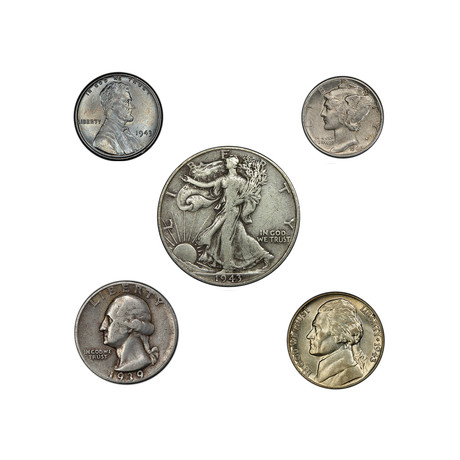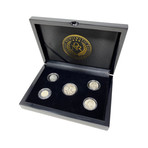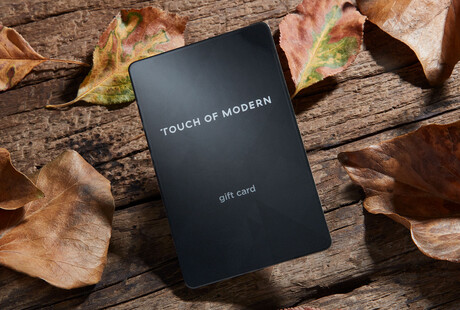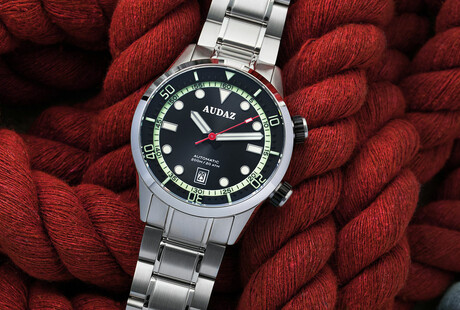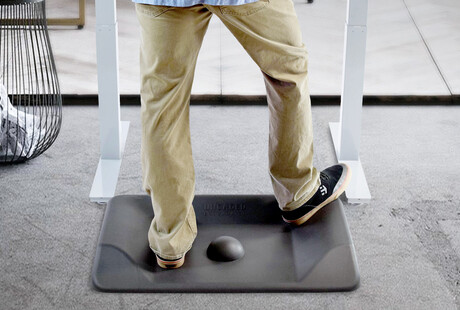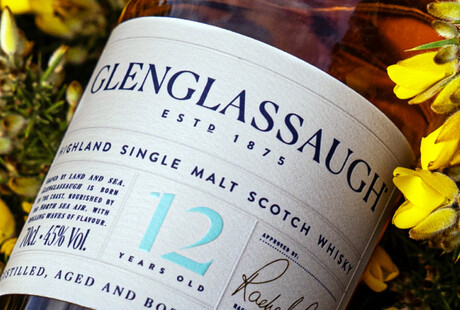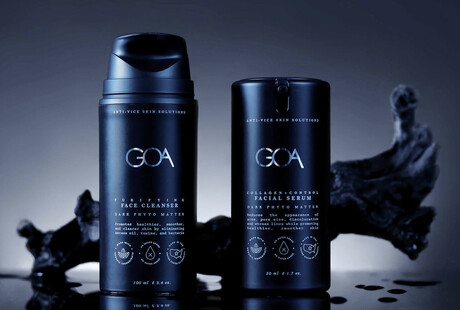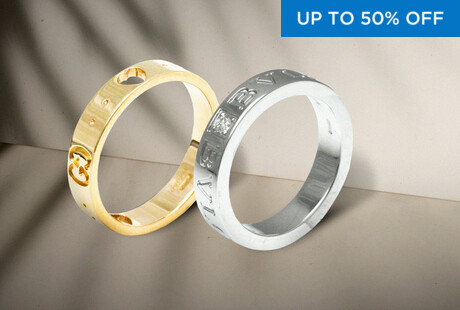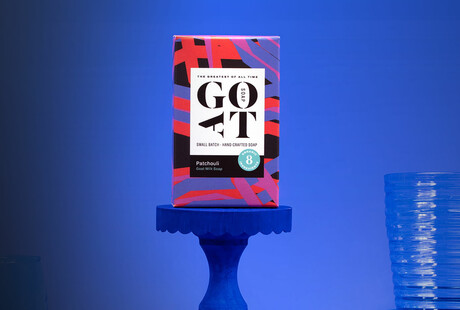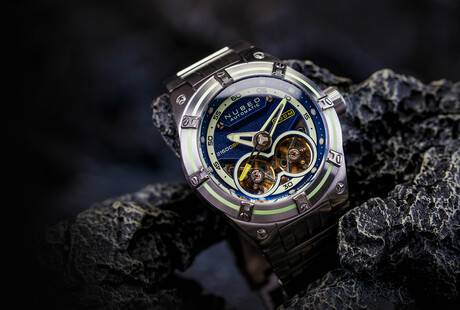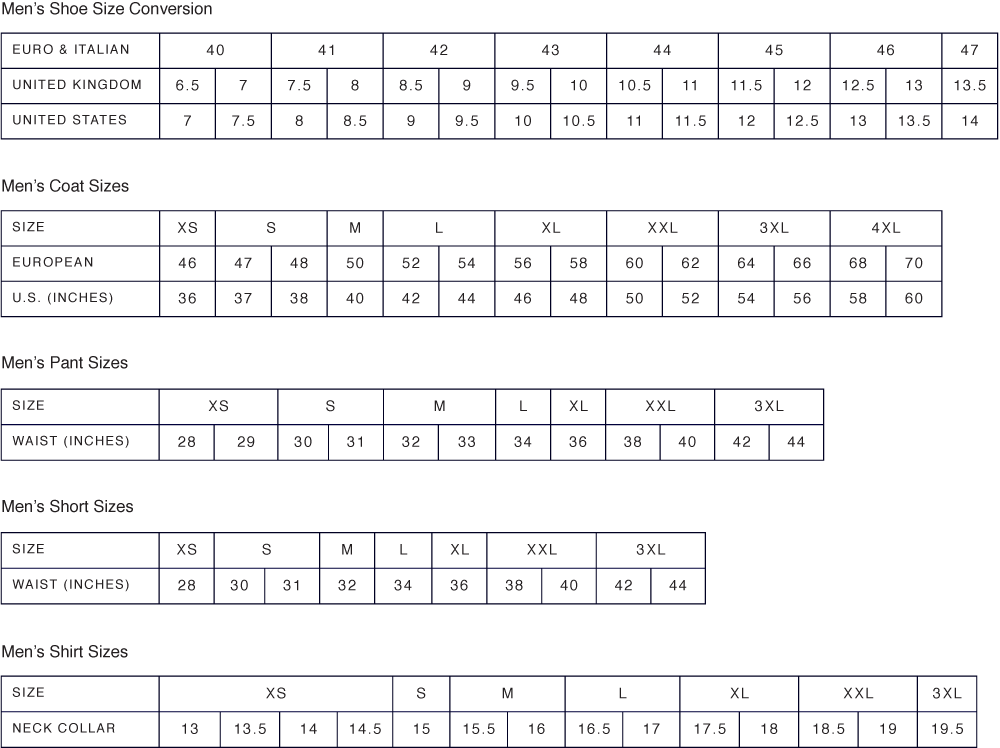Olevian Numismatic Rarities
World War II U.S. 5-Coin Set // Relics of a Bygone Era Series // Wood Presentation Box
Product Description
This memorable set features 5 different classic coins issued during World War II, including the emergency issue steel Lincoln cent and silver Jefferson nickel, as well as the Mercury dime, Washington quarter, and Walking Liberty half dollar. Each coin is housed in an airtight capsule and presented in a luxurious, plush-lined wood box with embossed metallic gold lettering, piano-black finish, and certificate of authenticity. The coins are unconditionally guaranteed to be genuine, minted between 1939 and 1945, and will match the quality of the ones shown.
The Lincoln cent is an enduring American classic produced for the past 112 years, making it the longest running United States coin design in existence, albeit with modification. In 1905, famed sculptor Augustus Saint-Gaudens was hired by the Mint at the request of President Roosevelt to beautify the nation’s coinage. Although Saint-Gaudens successfully redesigned the $10 and $20 gold pieces, he died in 1907 before he could submit designs for the new cent. Consequently, the Mint commissioned Victor D. Brenner in January of 1909 to design a one cent coin honoring Abraham Lincoln on the centennial of his birth. This marked the first widely circulating U.S. coin to feature the likeness of a President, as this concept had previously been considered too monarchical, particularly by George Washington. The obverse featured a bust of Lincoln, while the reverse depicted two stalks of wheat, representing staples of the U.S. economy, flanking the denomination. Brenner’s revolutionary design was approved, and the new coins were released to the public on August 2nd, 1909 with much fanfare. Like the outgoing Indian cent, the new Lincoln cent was composed primarily of copper. However, copper became a critical military resource during World War II, so the U.S. government decided to divert the copper reserves used for manufacturing Lincoln cents to aid the war efforts. At the height of the war in 1943 and with no better options, the U.S. Mint decided to produce the one cent coin in a zinc-plated steel composition as an emergency measure for one year only, with resumption of the ordinary copper composition in 1944. The Lincoln cent continued to feature the wheat stalk reverse until the sesquicentennial of Lincoln’s birth in 1959, at which point a new reverse depicting the Lincoln Memorial was introduced. This set includes a WWII emergency-issue 1943 Lincoln cent struck in zinc-plated steel.
Thomas Jefferson was a man of many talents. He is best known as the principle author of the Declaration of Independence and third president of the United States from 1801 to 1809. Jefferson’s achievements as an architect, statesman, scientist, and philosopher have earned him a lasting legacy as one of the truly great figures in American history. It is no surprise that his likeness eventually appeared on circulating U.S. coinage in 1938 and has continued to do so for over 80 years. The Jefferson nickel was designed by German-American sculptor Felix Schlag, who was awarded a $1,000 prize in April of 1938 when his model was selected among those submitted by 390 contestants. Schlag’s portrait of Jefferson was based on a marble bust by famed French sculptor Jean-Antoine Houdon. The Jefferson nickel features the left-facing president dressed in a coat of the period and wearing a peruke wig. On the reverse is a front elevation of Jefferson’s home, with the name MONTICELLO beneath it. The novelty of the Jefferson Nickel caused most examples to be saved by a curious public during its first few years, and the coin was not a familiar sight in circulation until about 1940. Shortly thereafter, the onset of World War II prompted the rationing of many commodities, including nickel, which was highly valued for use in armor plating. Congress ordered the removal of this metal from the five-cent piece, effective October 8, 1942. From that date until the end of 1945, five-cent pieces bore the regular design but were minted from an alloy of silver, copper, and manganese. These emergency coins were to be withdrawn from circulation after the war, so a prominent distinguishing feature was added. Coins from all three mints bore large mintmarks above the dome of Monticello, and the letter ‘P’ was used as a mintmark for Philadelphia for the first time. These “war nickels” proved quite satisfactory in circulation and were not immediately withdrawn. Instead, they remained a familiar sight until the mid-1960s, when rising silver prices caused them to be hoarded for their bullion value. Jefferson nickel production continues today in its original 1938 composition, albeit with several design modifications in recent years to modernize our nation’s coinage. This set includes a WWII emergency-issue Jefferson nickel struck in silver between 1942 and 1945.
Properly known as the “Winged Liberty” dime in the Mint’s official description, this popular coin features a stunning example of a youthful Lady Liberty on the obverse wearing a winged Phrygian cap to symbolize freedom of thought. However, this was publicly confused almost immediately after its release in October of 1916 with a likeness of the Roman God Mercury, and thus this coin’s enduring colloquial name was born. The reverse features the fasces carried by Roman magisterial lictors and symbolizes power and justice, as well as strength in numbers, and is accompanied by an olive branch of peace. The Mercury dime spanned an era that witnessed two World Wars, the Roaring Twenties, the Great Depression, and the entirety of Prohibition. It continues to be one of the most beloved coins in American history, more than 70 years after its last mintage in 1947.
As the dark shadow of economic depression fell across the United States in 1931, there was extraordinarily little to celebrate. However, one opportunity did present itself the following year: the 200th birthday of America’s first president. George Washington has been called the “Father of His Country” for his influential leadership in the formative days of the new nation. He led Patriot forces to victory during the Revolutionary War and later presided at the Constitutional Convention of 1787, which established the U.S. Constitution and a federal government. Washington then served that government as first president from 1789 to 1797. The Treasury Department had originally proposed that a half dollar be struck to honor Washington, but this was soon changed to the quarter when it was determined that replacing the half dollar would require congressional approval. A design by medalist John Flanagan was ultimately chosen, which featured an obverse depiction of Washington modeled after the famous bust created by French sculptor Jean Antoine Houdon. This bust was formed from a life-mask of Washington’s face taken at Mount Vernon in 1785 and is considered a highly accurate reproduction. The reverse of the coin features a bald eagle with outstretched wings clutching a bundle of arrows in its talons. Two olive branches of peace appear below. The Washington quarter was struck yearly in silver until rising bullion prices necessitated a compositional change to copper-nickel clad in 1965. For the nation’s bicentennial in 1976, a special reverse depicting a colonial drummer boy was issued and all coins featured the dual date of 1776-1976. The popularity of the Washington quarter amongst collectors has exploded in recent years, largely due to the introduction of the 50 State Quarters Program in 1999, which featured different reverses honoring each of the 50 states, 5 territories, and Washington, D.C. over an 11 year period. The America the Beautiful Quarters Program launched in 2010 showcases different National Park Service sites for each of 56 jurisdictions and will continue until 2021. This set includes an early example of the original Washington quarter design struck in silver during World War II.
The Walking Liberty half dollar is an enduring classic engraved by Adolph A. Weinman, the designer of the Mercury dime. This graceful coin features Lady Liberty adorned in an American Flag and striding towards the rising sun with her right arm outstretched, carrying branches of laurel and oak. The reverse features a powerful perched eagle with open wings and a branch of Mountain Pine, symbolic of America. The design was exceptionally detailed compared to previous coins, which lead to persistent problems with sharpness of strike and production quality— accelerating its replacement by the Franklin half dollar in 1948. The lasting beauty of this unique design was immortalized in 1986 when the U.S. Mint chose to adopt the Walking Liberty obverse for the American Silver Eagle bullion coin, which has become one of the most widely distributed silver bullion coins in the world. Today, many of the Walking Liberty half dollar issues are scare in high grades and completion of an entire collection of these coins in uncirculated condition remains a formidable challenge for collectors and investors alike.
Product Details
- Measurements
8"L x 6"W x 2"H
- OriginUnited States
Coin 1:
— Type: Lincoln Wheat Cent (1909-1958)
— Variety: Zinc-plated Steel (1943)
— Designer: Victor David Brenner
— Weight: 2.70 grams
— Diameter: 19.00 mm
— Composition: Zinc-coated steel
— Obverse Design: Abraham Lincoln, facing right
— Obverse Inscription: LIBERTY / IN GOD WE TRUST / DATE
— Reverse Design: Wheat stalks flanking denomination
— Reverse Inscription: UNITED STATES OF AMERICA / E PLURIBUS UNUM / ONE CENT
Coin 2:
— Type: Jefferson Nickel (1938-Present)
— Variety: Silver (1942-1945)
— Designer: Felix Schlag
— Weight: 5.00 grams
— Diameter: 21.2 mm
— Composition: 0.560 copper, 0.350 silver, 0.090 manganese
— Net silver weight: 0.56260 troy ounces
— Obverse Design: Thomas Jefferson, facing left
— Obverse Inscription: IN GOD WE TRUST / LIBERTY / DATE
— Reverse Design: Monticello
— Reverse Inscription: UNITED STATES OF AMERICA / E PLURIBUS UNUM / FIVE CENTS
Coin 3:
— Type: Mercury Dime (1916-1947)
— Designer: Adolph A. Weinman
— Weight: 2.50 grams
— Diameter: 17.9 mm
— Composition: 0.900 silver, 0.100 copper
— Net silver weight: 0.07234 oz pure silver
— Obverse Design: Liberty with winged cap
— Obverse Inscription: LIBERTY / IN GOD WE TRUST / DATE
— Reverse Design: Fasces with axe / Olive branch
— Reverse Inscription: UNITED STATES OF AMERICA / E PLURIBUS UNUM / ONE DIME
Coin 4:
— Type: Washington Quarter (1932-Present)
— Variety: Silver (1932-1964)
— Designer: John Flanagan
— Weight: 6.30 grams
— Diameter: 24.3 mm
— Composition: 0.900 silver, 0.100 copper
— Net silver weight: 0.18084 oz pure silver
— Obverse Design: George Washington, facing left
— Obverse Inscription: IN GOD WE TRUST / LIBERTY / DATE
— Reverse Design: Eagle with outstretched wings, clutching bundle of arrows in talons / Olive branch
— Reverse Inscription: UNITED STATES OF AMERICA / E PLURIBUS UNUM / QUARTER DOLLAR
Coin 5:
— Type: Walking Liberty Half Dollar (1916-1947)
— Designer: Adolph A. Weinman
— Weight: 12.5 grams
— Diameter: 30.6 mm
— Composition: 0.900 silver, 0.100 copper
— Net silver weight: 0.36169 oz pure silver
— Obverse Design: Liberty wearing an American flag dress with outstretched arm and carrying branches of laurel and oak / Mountain with rising sun in distance
— Obverse Inscription: LIBERTY / IN GOD WE TRUST / DATE
— Reverse Design: Perched eagle with open wings carrying branch of Mountain Pine
— Reverse Inscription: UNITED STATES OF AMERICA / E PLURIBUS UNUM / HALF DOLLAR
Please Note: The item(s) you receive will match the quality of the one shown, but may vary slightly due to the nature of original historical artifacts.
Shipping Information
-
Shipping AvailabilityCanada, United States
-
Shipping PolicyStandard Ground Shipping
-
Ship In3-4 weeks ⓘ
-
Return PolicyFinal sale, not eligible for return or cancellation
